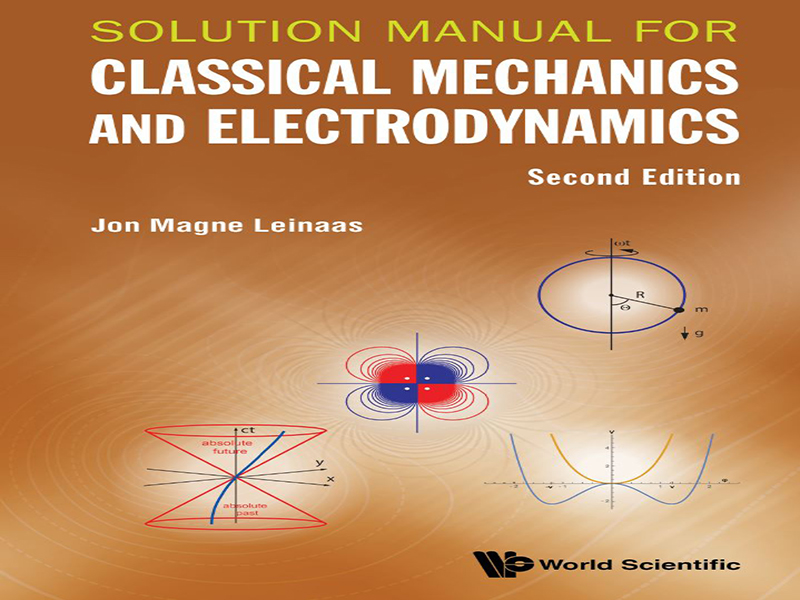- عنوان کتاب: SOLUTION MANUAL FOR CLASSICAL MECHANICS AND ELECTRODYNAMICS
- نویسنده: Jon Magne Leinaas
- حوزه: مکانیک کلاسیک
- سال انتشار: 2025
- تعداد صفحه: 157
- زبان اصلی: انگلیسی
- نوع فایل: p7.60 مگابایت
چهار سیستم مکانیکی مورد مطالعه قرار گرفتهاند. در همه موارد، تعداد درجات آزادی مشخص شده و مجموعهای مناسب از مختصات تعمیمیافته انتخاب شده است. الف) سیستم اول شامل یک پاندول متصل به یک بلوک است که به نوبه خود به یک فنر متصل است. فرض میکنیم تمام حرکت در یک صفحه دوبعدی و عمودی انجام میشود. بلوک به حرکت در جهت افقی محدود شده است و پاندول توسط طول ثابت میله محدود شده است. با شروع از دو درجه آزادی برای هر یک از دو جسم، این دو قید تعداد درجات آزادی را به دو کاهش میدهند، یکی برای هر جسم. یک انتخاب طبیعی از مختصات تعمیمیافته، جابجایی افقی x بلوک و زاویه θ میله نسبت به جهت عمودی است. ب) سیستم دوم شامل یک پاندول متصل به یک دیسک عمودی است که با فرکانس زاویهای ثابت میچرخد. همچنین در اینجا حرکت محدود به یک صفحه دوبعدی و عمودی را در نظر میگیریم. هیچ درجه آزادی مربوط به دیسک چرخان وجود ندارد، زیرا دارای فرکانس زاویهای خارجی تعیینشده است. آونگ دوباره فقط توسط طول ثابت میله محدود میشود و بنابراین تعداد درجات آزادی سیستم برابر با یک است. یک انتخاب طبیعی برای مختصات تعمیمیافته، زاویه θ بین میله آونگ و جهت عمودی است. ج) در حالت سوم، یک میله صلب میتواند بدون لغزش روی بالای استوانه کج شود، در حالی که استوانه میتواند روی یک صفحه افقی بغلتد. با فرض مجدد اینکه حرکت به یک صفحه عمودی دو بعدی محدود شده است، نقطه شروع برای هر جسم سه درجه آزادی است. برای استوانه، این مربوط به دو مختصات برای مرکز جرم آن و یکی برای زاویه چرخش آن است. برای میله، دو مختصات برای تعیین موقعیت مرکز جرم آن و یک مختصات برای تعیین زاویه میله نسبت به جهت افقی (یا عمودی) مورد نیاز است.
Four mechanical systems are studied. In all cases the number of degrees of freedom are specified, and an appropriate set of generalized coordinates is chosen. a) The first system consists of a pendulum attached to a block which in turn is attached to a spring. We assume all motion takes place in a twodimensional, vertical plane. The block is constrained to move in the horizontal direction, and the pendulum is constrained by the constant length of the rod. Starting from two degrees of freedom for each of the two objects, the two constraints reduce the number of degrees of freedom to two, one for each object. A natural choice of generalized coordinates is the horizontal displacement x of the block and the angle θ of the rod relative to the vertical direction. b) The second system consists of a pendulum attached to a vertical disk, which rotates with a fixed angular frequency. Also here we consider the motion restricted to a two-dimensional, vertical plane. There is no degree of freedom related to the rotating disk, since it has an externally determined angular frequency. The pendulum is again only constrained by the fixed length of the rod, and the number of degrees of freedom of the system is therefore one. A natural choice of generalized coordinate is the angle θ between the pendulum rod and the vertical direction. c) In the third case a rigid rod can tilt without sliding on the top of the cylinder, while the cylinder can roll on a horizontal plane. Assuming again that the motion is restricted to a two-dimensional, vertical plane, the starting point is three degrees of freedom for each object. For the cylinder this corresponds to two coordinates for its center of mass and one for its angle of rotation. For the rod there are two coordinates needed to determine the position of its center of mass, and one coordinate to determine the angle of the rod relative to the horizontal (or vertical) direction.
این کتاب را میتوانید از لینک زیر بصورت رایگان دانلود کنید:
Download: SOLUTION MANUAL FOR CLASSICAL MECHANICS AND ELECTRODYNAMICS



































نظرات کاربران